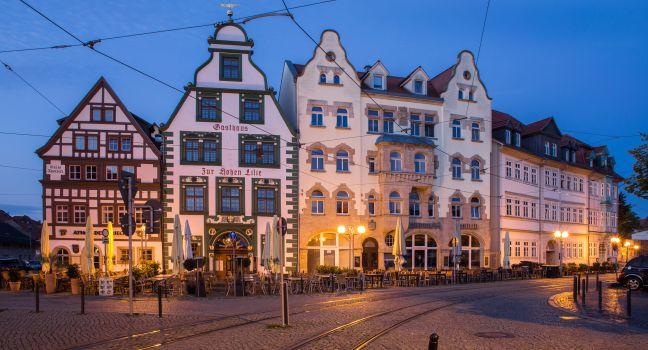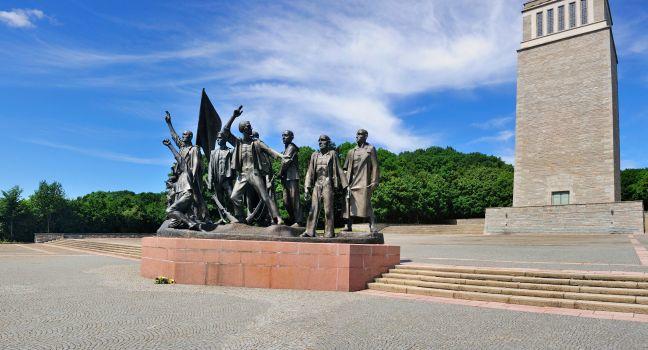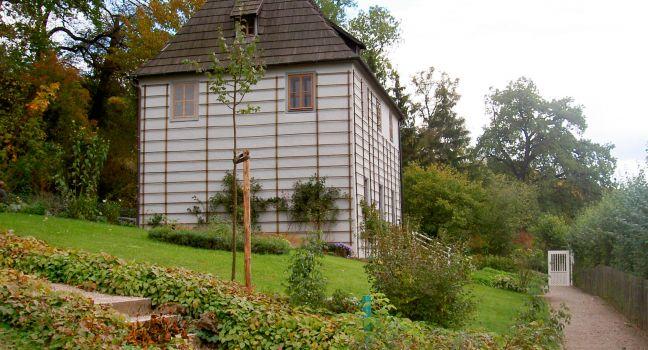Domplatz

Erfurt's most picturesque square is bordered by houses dating from the 16th century and dominated by twin churches. The daily market is a great place to get a Thuringian bratwurst from one of the many stands.
Get FREE email communications from Fodor's Travel, covering must-see travel destinations, expert trip planning advice, and travel inspiration to fuel your passion.
Sorry! We don't have any recommendations for Saxony, Saxony-Anhalt and Thuringia right now.
We’ve compiled the best of the best in Saxony, Saxony-Anhalt and Thuringia - browse our top choices for the top things to see or do during your stay.

Erfurt's most picturesque square is bordered by houses dating from the 16th century and dominated by twin churches. The daily market is a great place to get a Thuringian bratwurst from one of the many stands.
On the southeast side of the upper market lies this pleasant Romanesque church with a Gothic interior, built in 1245. The interior houses an impressive Gothic triptych altarpiece. The clock on the thin tower is set seven minutes fast in remembrance of a trick played by the city guards on the leaders of a rebellion. In 1527 the city's disenfranchised cloth makers secretly met to plan a rebellion against the city council and the powerful guilds. Their plans were uncovered, and by setting the clock ahead the guards fooled the rebels into thinking it was safe to sneak into the city. As a result they were caught and hanged.
Lucas Cranach the Elder—court painter, printer, mayor, pharmacist, friend of Luther's, and probably the wealthiest man in Wittenberg—lived in two houses during his years in town. This Cranachhaus is believed to have been the first one. His son, the painter Lucas Cranach the Younger, was born here. Some of the interior has been restored to its 17th-century condition. It's now a gallery with exhibits about Cranach's life and work. Check out the goldsmith and potter that are occasionally on hand demonstrating their crafts in the courtyard.
Quedlinburg’s skyline is dominated by the Schlossberg. The original town that became Quedlinburg forms the base of the hill. The half-timber houses in this are much smaller than those in the Old Town as they housed handworkers and artisans that supported the Abbey. The hill is ringed by the Wassertorstrasse and a small footpath that make exploring this area picturesque and easy. Finkenherd Square hosts a large collection of medieval half-timber houses. The house at Finkenherd #1 is where, in 919, Heinrich I learned that he would be king. On the way up to the castle, stop at Vincent's Käsekuchenbäckerei for the best cheesecake in Quedlinburg.
The city's medieval past is recounted in the museum of this former monastery.
A set of porcelain bells at the late-Gothic Frauenkirche, on the central Marktplatz, was the first of its kind anywhere when installed in 1929.

Just north of Weimar, amid the natural beauty of the Ettersberg hills that once served as Goethe's inspiration, sits the blight of Buchenwald, one of the most infamous Nazi concentration camps. Fifty-six thousand men, women, and children from 35 countries met their deaths here through forced labor, starvation, disease, and gruesome medical experiments. Each is commemorated by a small stone placed on the outlines of the barracks, which have long since disappeared from the site, and by a massive memorial tower. In an especially cruel twist of fate, many liberated inmates returned to the camp as political prisoners of the Soviet occupation; they are remembered in the exhibit Soviet Special Camp #2. Besides exhibits, tours are available. To reach Buchenwald by public transportation, take Bus 6 (in the direction of Buchenwald, not Ettersburg), which leaves every 10 minutes from Goetheplatz in downtown Weimar. The one-way fare is €2.20
This museum, in the northwestern corner of the complex, was built to house portions of the royal art collections. Among the priceless paintings are works by Dürer, Holbein, Jan Van Eyck, Rembrandt, Rubens, van Dyck, Hals, Vermeer, Raphael, Titian, Giorgione, Veronese, Velázquez, Murillo, Canaletto, and Watteau. On the wall of the entrance archway you'll see an inscription in Russian, one of the few amusing reminders of World War II in Dresden. It rhymes in Russian: "Museum checked. No mines. Chanutin did the checking." Chanutin, presumably, was the Russian soldier responsible for checking one of Germany's greatest art galleries for anything more explosive than a Rubens nude. The highlight of the collection is Raphael's Sistine Madonna, whose mournful look is slightly less famous than the two cherubs who were added by Raphael after the painting was completed, in order to fill an empty space at the bottom.
Like other older buildings in downtown Dessau, this Dutch-baroque church, built in 1712, is quite a contrast to the no-nonsense Bauhaus architecture.

Goethe's first house in Weimar, the beloved Gartenhaus, is a modest country cottage where he spent many happy hours, wrote much poetry, and began his masterly classical drama Iphigenie. The house is set amid meadowlike parkland on the bank of the River Ilm. Goethe is said to have felt very close to nature here, and you can soak up the same rural atmosphere on footpaths along the peaceful little river.
Evidence of a wealthy Jewish community can be found in the large art nouveau Synagogue. With 650 seats the building, completed in 1911, would have been the largest synagogue in Saxony.
During the Kristallnacht Nazis set the building on fire, but the building only suffered minor damage as the Fire Department ignored orders to let the building burn. The last service took place here in 1940. Almost none of Görlitz’s Jews survived the war and Soviet Military authorities placed the synagogue under the control of the community in Dresden. The city of Görlitz purchased the building in 1963 and it served a variety of functions until German unification.
In 2008 the city and an associated foundation began the reconstruction of the building. Although there is no large community in Görlitz, the newly refurbished synagogue is again open to the public and held its first service in August 2021. The main building is an interesting public space that explores the history and cultural impact of Jews in Silesia. In December 2021, the remains of the Torah, thought destroyed by the Nazis, was returned to the synagogue after being hidden by a sympathetic priest.
This museum showcases 2,000 years of works from Leipzig's and eastern Germany's proud tradition of handicrafts, such as exquisite porcelain, fine tapestry art, and modern Bauhaus design.
Historical musical instruments, mostly from the Renaissance, include the world's oldest clavichord, constructed in 1543 in Italy. There are also spinets, flutes, and lutes. Recordings of the instruments can be heard at the exhibits.
Presenting arts and crafts from all continents and various eras, this museum includes a thrilling collection of Southeast Asian antique art and the world's only Kurile Ainu feather costume, in the Northeast Asia collection. This museum stands at the forefront of a growing movement to assess Germany's colonial past and repatriation of looted art.
British "starchitect" David Chipperfield restored and modernized this fine example of German art deco in 2003–05. The building, which opened in 1929, houses three important museums.
With 26 platforms, Leipzig's main train station is Europe's largest railhead. It was built in 1915 and is now a protected monument, but modern commerce rules in its bi-level shopping mall, the Promenaden. The only thing the complex is missing is a pub. Many of the shops and restaurants stay open until 10 pm and are open on Sunday. Thanks to the historic backdrop, this is one of the most beautiful shopping experiences in Saxony.
This modest, cubical structure designed by Georg Muche for the 1923 Bauhaus exhibition is the first structure constructed using the Bauhaus’s new philosophy of functional modernity. The house is a small cubist structure comprised of concrete and stone walls with a flat roof and is a model for the Meisterhäuser in Dessau. All of the furniture was created specifically for the house by students of the Bauhaus design school.
This museum makes a valiant attempt to evaluate the history of the GDR. It provides fascinating insight into the day-to-day culture of East Germans through the re-creation of a typical East German apartment, and a display of more than 20,000 objects, including detergent packaging and kitchen appliances. A special section deals with Germans and Russians in the Wittenberg region.
Ask anyone where to find the Church of St. Peter and Paul and they will give you a confused look, but everyone knows the church associated with the philosopher Wilhelm Gottfried Herder. The Marktplatz's late-Gothic church has a large winged altar started by Lucas Cranach the Elder and finished by his son in 1555. The elder Cranach lived in a nearby house (two blocks east of Theaterplatz) during his last years, 1552–53. Its wide, imposing facade is richly decorated and bears the coat of arms of the Cranach family, but almost none of the gothic interior remains. The church also houses a modern art gallery.
With Schloss Neuenberg looming above, there is no more picturesque place to stop for a glass of wine or tour when you are exploring the Unstrut Valley than this serene terraced vineyard with its well-preserved baroque 18th-century vineyard house. The vintners welcome visitors for a tour of the vineyards every day at 11 from April to October. The highlight is the relaxed tasting area with generous pours and picnic lunches available to enjoy in the garden.
Below the waterworks and outside the walls, these three reddish houses were the only structures to survive all the city's fires—leading Bautzeners to conclude that they could only be occupied by witches.
Goethe and Schiller are buried in this leafy cemetery, where virtually every gravestone commemorates a famous citizen of Weimar. Their tombs are in the vault of the classical-style chapel. The cemetery is a short walk past Goethehaus and Wieland Platz.
This section of the castle most reflects Augustus the Strong's obsession with art as a symbol of power. The intricately restored baroque interior is an integral part of the presentation, highlighting the objects in the collection. The last section of the museum houses the Jewel Room, which displays the ceremonial crown jewels of Augustus the Strong and his son. Access to the Historic Green Vault is limited to 100 visitors per hour and is by appointment only, reserved by phone or online.
The largest Catholic church in Saxony is also known as the Cathedral of St. Trinitatis. Frederick Augustus II (who reigned 1733–63) brought architects and builders from Italy to construct a Catholic church in a city that had been the first large center of Lutheran Protestantism (like his father, Frederick Augustus II had to convert to Catholicism to be eligible to wear the Polish crown). The bridge between the residence and the church was the way for August to attend mass without being seen by the public. Inside, the treasures include a beautiful stone pulpit by the royal sculptor Balthasar Permoser and a painstakingly restored 250-year-old organ, said to be one of the finest ever to come from the mountain workshops of the famous Silbermann family. There is a small, yet powerful memorial to the bombing of Dresden in the nave to the rear. In the cathedral's crypt are the tombs of 49 Saxon rulers and a reliquary containing the heart of Augustus the Strong, which is rumored to start beating if a beautiful woman comes near.
Built in 1912–13, Germany's only original art nouveau department store has a main hall with a colorful glass cupola and several stunning freestanding staircases. The store dominates the Marienplatz, a small square outside the city center that serves as Görlitz's transportation hub. It's next to the 15th-century Frauenkirche, the parish church for the nearby hospital and the poor condemned to live outside the city walls. In 2013 a private investor purchased the building with plans to renovate it and open a high-end department store. At this writing, the building is still being restored, but there is no concrete date to reopen it. It may be possible to look around the inside during the renovation.
Supported by seven Gothic gables, the Kaysersches Haus the carved oak doorway is from the Renaissance.
Perched high above the river is one of Saxony's largest late-Gothic churches, dating to 1423. The real draw is the church's famous one-of-a-kind organ, built in 1703 by Eugenio Casparini. The Sun Organ gets its name from the circularly arranged pipes and not from the golden sun at the center. Its full and deep sound, as well as its birdcalls, can be heard on Sunday and Wednesday afternoons.


 Sign up for Travel Tips & News
Sign up for Travel Tips & News
 Thank you for your interest!
Thank you for your interest!